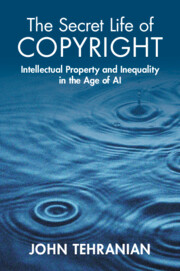Refine search
Actions for selected content:
243 results
Introduction: Human Rights and Distributive Justice
-
- Book:
- In Defense of Economic and Social Human Rights
- Published online:
- 06 November 2025
- Print publication:
- 20 November 2025, pp 1-30
-
- Chapter
- Export citation
Case 3.4 - What Am I Missing?
- from Part III - Case Studies in Mezzo-Level Practice
-
-
- Book:
- Critical Race Theory in Action
- Published online:
- 25 October 2025
- Print publication:
- 13 November 2025, pp 97-110
-
- Chapter
- Export citation
Case 4.3 - Advancing the Voices of Those Who Are Marginalized
- from Part IV - Case Studies in Macro-Level Practice
-
-
- Book:
- Critical Race Theory in Action
- Published online:
- 25 October 2025
- Print publication:
- 13 November 2025, pp 150-163
-
- Chapter
- Export citation

In Defense of Economic and Social Human Rights
- An Intellectual History, 1940 to the Present
-
- Published online:
- 06 November 2025
- Print publication:
- 20 November 2025
Situating guilt: social injustice as a partial excuse
-
- Journal:
- Legal Studies , FirstView
- Published online by Cambridge University Press:
- 27 October 2025, pp. 1-19
-
- Article
-
- You have access
- Open access
- HTML
- Export citation
5 - How did we get here? The history of critical social work
-
- Book:
- Engaging with Social Work
- Published online:
- 09 October 2025
- Print publication:
- 23 October 2025, pp 134-160
-
- Chapter
- Export citation
Chapter 7 - Student diversity, education and social justice
- from Part III - Professional practice
-
-
- Book:
- Learning to Teach in a New Era
- Published online:
- 04 October 2025
- Print publication:
- 25 September 2025, pp 229-268
-
- Chapter
- Export citation
Social Justice in Hong Kong: Assessing the Role of Higher Education in Integrating Modern Social Justice Approaches into Legal Practice in the HKSAR
-
- Journal:
- Asian Journal of Law and Society , First View
- Published online by Cambridge University Press:
- 16 September 2025, pp. 1-21
-
- Article
-
- You have access
- Open access
- HTML
- Export citation
11 - Social Justice in Water Management
-
- Book:
- Satellite Remote Sensing for Water Management
- Published online:
- 10 October 2025
- Print publication:
- 04 September 2025, pp 306-322
-
- Chapter
- Export citation
Chapter 14 - Stand-Up Comedy and Trauma
- from Part III - Performance Dynamics
-
-
- Book:
- The Cambridge Companion to Stand-Up Comedy
- Published online:
- 21 August 2025
- Print publication:
- 04 September 2025, pp 273-289
-
- Chapter
- Export citation
Preface
-
- Book:
- Satellite Remote Sensing for Water Management
- Published online:
- 10 October 2025
- Print publication:
- 04 September 2025, pp xiii-xv
-
- Chapter
- Export citation
Chapter 9 - Stand-Up Comedy, Disability, and Social Justice
- from Part II - Interpretation and Meaning
-
-
- Book:
- The Cambridge Companion to Stand-Up Comedy
- Published online:
- 21 August 2025
- Print publication:
- 04 September 2025, pp 175-188
-
- Chapter
- Export citation
Chapter 20 - Values and social justice education
- from Part V - HASS for all learners
-
-
- Book:
- Making Humanities and Social Sciences Come Alive
- Published online:
- 02 August 2025
- Print publication:
- 14 August 2025, pp 340-354
-
- Chapter
- Export citation
2 - The Real Person Approach
- from Part II - Paradigm and Principle
-
- Book:
- The Boundaries of Blame
- Published online:
- 26 July 2025
- Print publication:
- 14 August 2025, pp 49-78
-
- Chapter
- Export citation

The Secret Life of Copyright
- Intellectual Property and Inequality in the Age of AI
-
- Published online:
- 08 August 2025
- Print publication:
- 14 August 2025
6 - NJMs and the Conflicting Roles of the State
-
- Book:
- Global Business and Local Struggle
- Published online:
- 18 July 2025
- Print publication:
- 07 August 2025, pp 170-196
-
- Chapter
- Export citation
Introduction: Inflated Promises and Small Victories
-
- Book:
- Global Business and Local Struggle
- Published online:
- 18 July 2025
- Print publication:
- 07 August 2025, pp 1-15
-
- Chapter
- Export citation
19 - Educational Equity and Student Learning in School–University Partnerships
- from Part III - Equity and Student Learning in School–University Partnerships
-
-
- Book:
- The Cambridge Handbook of School–University Partnerships
- Published online:
- 05 November 2025
- Print publication:
- 07 August 2025, pp 308-322
-
- Chapter
- Export citation
2 - Oracy and Social (In)Justice
- from Part I - Debating Oracy in the UK
-
-
- Book:
- Oracy
- Published online:
- 23 September 2025
- Print publication:
- 31 July 2025, pp 26-39
-
- Chapter
- Export citation
7 - ‘We Got to Take Back Our Country’
- from Part II - Local Dynamics of Decolonisation
-
- Book:
- Global Decolonisation and Non-Sovereignty
- Published online:
- 16 September 2025
- Print publication:
- 31 July 2025, pp 196-231
-
- Chapter
- Export citation
